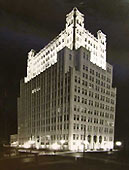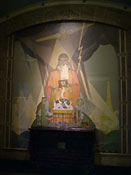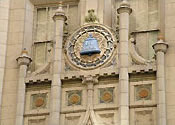National and State Register
Telephone Building
Denver County
The 1929 Telephone Building is important for its association with the growth and development of telephone communications in Denver and the Rocky Mountain region. The building served as the headquarters of the seven-state region Mountain States Telephone and Telegraph (later Mountain Bell) from 1929 until 1984. Architecturally, the building is one of the finest examples in the country of the American Perpendicular style, designated by the Bell system as "Modern American Perpendicular Gothic."
The distinctive characteristics of the style reflected in the building are the expressed verticality, steel framework, terra cotta sheathing, varied setbacks, continuous piers, stylized towers, recessed spandrels, and Gothic Revival style ornament. The building is the largest and most important commercial design of prominent Denver architect William N. Bowman. Bowman designed the building in conjunction with local Bell system engineers and it was erected by local builders and craftsman utilizing a variety of products from around the state. The building’s design took advantage of the setback provision of the city’s zoning ordinance, permitting buildings to rise higher than the nominal height limit of twelve stories if higher stories were setback from the wall-plane.
The building exhibits high artistic values, reflected in the intricate planning, lavish detail, and high quality craftsmanship displayed in its interior and exterior design. The terra cotta integral to the design of the building is among the finest crafted in Denver incorporates Gothic Revival design motifs, and includes mottled and polychromatic components, ornament in varied relief, extensive decorated panels, ornate arches, and massive piers. The Gothic Revival influence is echoed on the interior, which also includes aesthetic elements incorporating the history of telephone service in the state and representing emblems of the telephone company. The interior reflects the influence of noted Denver artist Allen True who selected color palettes, designed fixtures, and advised the architect regarding the choice of materials. The artist believed that beautiful surroundings had a positive psychological effect on workers, and he was a leader in the city in advocating carefully planned color schemes and artistic decoration for large office buildings. As part of this effort, True executed thirteen murals with communications and telephonic themes which grace the public spaces of the building. These murals are considered among True’s most outstanding work.
Finally, the Telephone Building is important in the area of engineering, for the technological advances embodied in its composition and construction. The architect and engineers worked in conjunction to design a building which would structurally meet the challenging practical needs of the telephone company while also serving aesthetic considerations. The building was erected to house the special equipment making possible the introduction of telephone dial service to Denver. The building was designed with an innovative independently fireproof core rising from the subbasement to the roof. The property is associated with the Historic Resources of Downtown Denver Multiple Property Submission.



